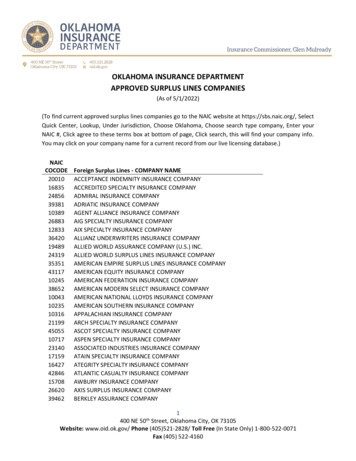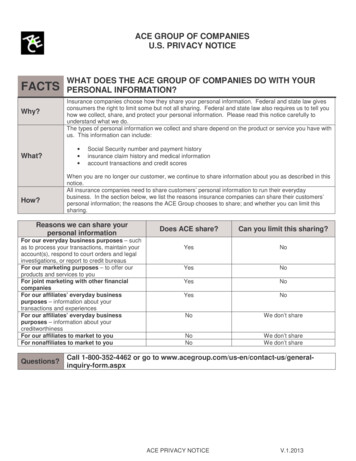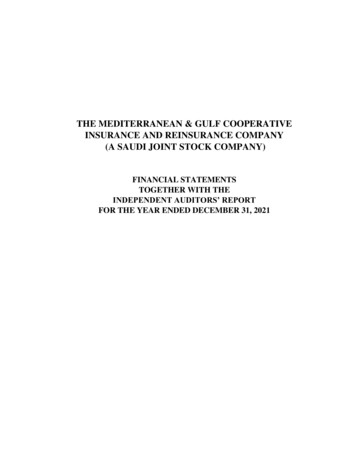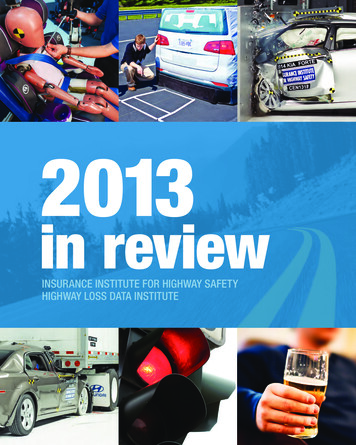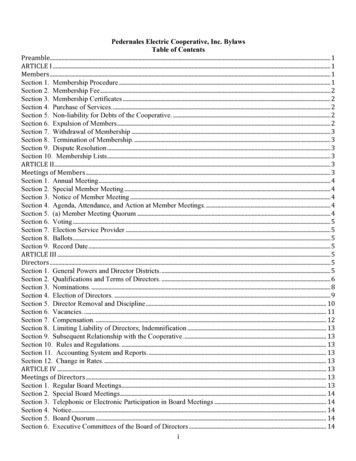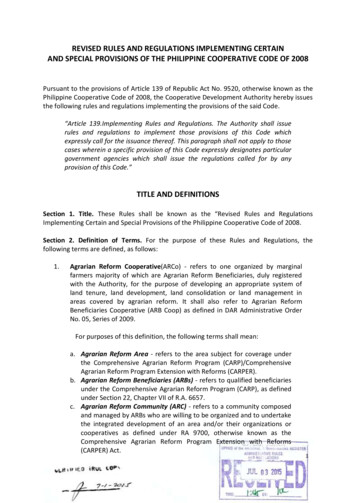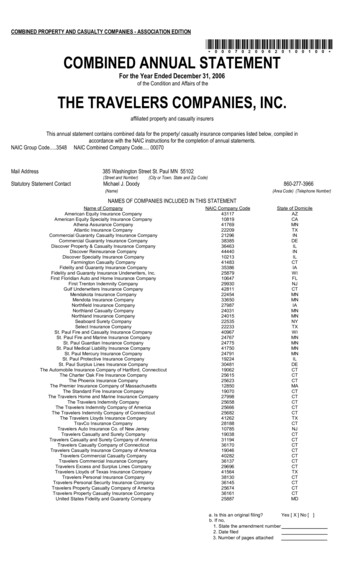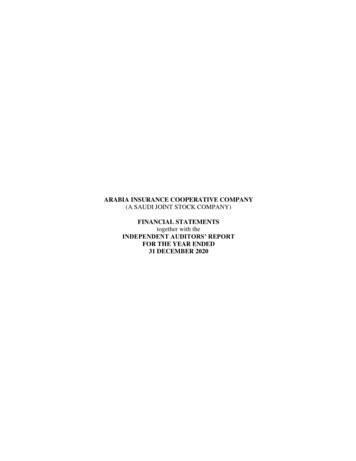
Transcription
ARABIA INSURANCE COOPERATIVE COMPANY(A SAUDI JOINT STOCK COMPANY)FINANCIAL STATEMENTStogether with theINDEPENDENT AUDITORS’ REPORTFOR THE YEAR ENDED31 DECEMBER 2020
ARABIA INSURANCE COOPERATIVE COMPANY(A SAUDI JOINT STOCK COMPANY)FINANCIAL STATEMENTS AND INDEPENDENT AUDITORS’ REPORTFOR THE YEAR ENDED 31 DECEMBER 2020INDEXIndependent Auditors’ reportPAGES1-5Statement of financial position6Statement of income7Statement of Comprehensive income8Statement of changes in shareholders’ equity9Statement of cash flows10Notes to the financial statements11 – 61
ARABIA INSURANCE COOPERATIVE COMPANY(A SAUDI JOINT STOCK COMPANY)NOTES TO THE FINANCIAL STATEMENTSFOR THE YEAR ENDED 31 DECEMBER 20201.ORGANISATION AND PRINCIPAL ACTIVITIESArabia Insurance Cooperative Company (the “Company”) is a Saudi Joint Stock Company registered in the Kingdom ofSaudi Arabia under commercial registration number 1010243302 dated 18 Muharram 1429H (corresponding to 27January 2008). The registered address of the Company is P.O. Box 28655, Riyadh 11323, Kingdom of Saudi Arabia.The objectives of the Company is to transact cooperative insurance business and carry out related activities in theKingdom of Saudi Arabia. Its principal activity includes all classes of general insurance, medical insurance, savings andprotection. The Company was listed on the Saudi Stock Exchange (Tadawul) on 26 Muharram 1429H (corresponding to4 February 2008). The Company started insurance and reinsurance operations on 4 Muhram 1430H (corresponding to 1January 2009).On 14 Jumada Thani 1435H (corresponding to 14 April 2014), the Saudi Arabian Monetary Authority (SAMA) issuedofficial approval numbered 351000076885 to amend the licence issued to the Company number TMN/15/20086 totransact insurance and reinsurance activities to be restricted to insurance activities only.The Company amended the Articles of Association in line with the amendments of the Saudi Companies Regulationsissued in 1437H (2015).2.BASIS OF PREPARATIONBasis of measurement and preparation:The financial statements have been prepared in accordance with International Financial Reporting Standards (IFRS) andother standards and pronouncements endorsed by the Saudi Organization for Certified Public Accountants (“SOCPA”),the Companies Law, and the Company’s bylaw.On 23 July 2019, the Saudi Central Bank (SAMA) instructed the insurance companies in the Kingdom of Saudi Arabiato account for the zakat and income taxes in the statement of income. This aligns with the IFRS and its interpretations asissued by the International Accounting Standards Board (“IASB”).As required by the Saudi Arabian Insurance Regulations, the Company maintains separate books of accounts for InsuranceOperations and Shareholders’ Operations and presents the financial statements accordingly. Revenues and expensesclearly attributable to either activity are recorded in the respective accounts. The basis of allocation of revenues andexpenses from joint operations is determined and approved by the management and the Board of Directors.The financial statements are prepared on the going concern basis and on the historical cost basis, except for available-forsale investments where they are measured at fair value and end of service benefits are measured at present value. Thebalance sheet is not displayed using the current / non-current classification. Nevertheless, the following balances aregenerally classified in circulation: cash and cash equivalents, insurance premiums receivable, reinsurance receivables,investments, deferred underwriting costs, prepaid expenses, other assets, accounts payable, reinsurers' receivables,outstanding claims, accrued expenses, other liabilities, provision for zakat, taxes, distribution of the surplus due and noninsurance premiums Earned, reimbursed share of unearned premiums, and deferred subscription costs unearnedcommission income,. The following balances are generally classified as non-current: end of service indemnities, statutorydeposit, returns on statutory deposit, commission income payable to the Saudi Central Bank, claims incurred but notreported, and property and equipment, net.The statement of financial position, statements of income, comprehensive income and cash flows of the insuranceoperations and shareholders’ operations which are presented in (Note 30) of the financial statements have been providedas supplementary financial information to comply with the requirements of the guidelines issued by SAMA implementingregulations.The company presents the statement of financial position in order of liquidity.-11-
ARABIA INSURANCE COOPERATIVE COMPANY(A SAUDI JOINT STOCK COMPANY)NOTES TO THE FINANCIAL STATEMENTS (CONTINUED)FOR THE YEAR ENDED 31 DECEMBER 20202.BASIS OF PREPARATION (continued)Basis of measurement and preparation: (continued)SAMA implementing regulations requires the clear segregation of the assets, liabilities, income and expenses of theinsurance operations and the shareholders’ operations. Accordingly, the statements of financial position, statements ofincome, comprehensive income and cash flows prepared for the insurance operations and shareholders operations asreferred to above, reflect only the assets, liabilities, income, expenses and comprehensive gains or losses of the respectiveoperations.In preparing the Company-level financial statements in compliance with IFRS, the balances and transactions of theinsurance operations are amalgamated and combined with those of the shareholders’ operations. Inter-operation balances,transactions and unrealised gains or losses, if any, are eliminated in full during amalgamation. The accounting policiesadopted for the insurance operations and shareholders’ operations are uniform for transactions and events in similarcircumstances.Functional and presentation currencyThese financial statements have been presented in Saudi Arabian Riyals (SAR), which is also the functional currency ofthe Company. All amounts has been rounded to the nearest Riyal.Financial yearThe company's financial year begins on January 1 and ends on December 31 of each calendar year.Significant accounting judgements, estimates and assumptionsThe preparation of the financial statements requires the use of estimates and judgments that affect the reported amountsof assets and liabilities and disclosure of contingent assets and liabilities at the date of the financial statements and thereported amounts of revenues and expenses during the reporting period. Although these estimates and judgments arebased on management’s best knowledge of current events and actions, actual results ultimately may differ from thoseestimates. Estimates and judgments are continually evaluated and based on historical experience and other factors,including expectations of future events that are believed to be reasonable under the circumstances. Moreover, the companyhas reviewed the main sources to estimate the uncertainty disclosed in the latest annual financial statements regarding theCoronavirus (Covid-19) pandemic, moreover, the company has considered the following:Impact of Covid-19On 11 March 2020, the World Health Organisation (“WHO”) declared the Coronavirus (“COVID-19”) outbreak as apandemic in recognition of its rapid spread across the globe. This outbreak has also affected the GCC region includingthe Kingdom of Saudi Arabia. Governments all over the world took steps to contain the spread of the virus. Saudi Arabiain particular has implemented closure of borders, released social distancing guidelines and enforced country widelockdowns and curfews.In response to the spread of the Covid-19 virus in the GCC and other where the Company operates and its consequentialdisruption to the social and economic activities in those markets, the Company’s management has proactively assessedits impacts on its operations and has taken a series of proactive and preventative measures and processes to ensure: The health and safety of its employees and the wider community where it is operatingThe continuity of its business throughout the Kingdom is protected and kept intact.The major impact of Covid-19 pandemic is seen in medical and motor line of business as explained below. As with anyestimate, the projections and likelihoods of occurrence are underpinned by significant judgment and rapidly evolvingsituation and uncertainties surrounding the duration and severity of the pandemic, and therefore, the actual outcomes maybe different to those projected.The impact of such uncertain economic environment is judgmental, and the Company will continue to reassess itsposition and the related impact on a regular basis.-12-
ARABIA INSURANCE COOPERATIVE COMPANY(A SAUDI JOINT STOCK COMPANY)NOTES TO THE FINANCIAL STATEMENTS (CONTINUED)FOR THE YEAR ENDED 31 DECEMBER 20202.BASIS OF PREPARATION (continued)Significant accounting judgements, estimates and assumptions (continued)Medical technical reserveBased on the management’s assessment, the management believes that the Government’s decision to assume the medicaltreatment costs for both Saudi citizens and expatriates has helped in reducing any unfavorable impact. During thelockdown, the Company saw a decline in medical reported claims (majorly elective and non-chronic treatment claims)which resulted in a drop in claims experience. However, subsequent to the lifting of lockdown since 21 June 2020, theCompany is experiencing a surge in claims which is in line with the expectations of the Company’s management. TheCompany’s management has duly considered the impact of surge in claims in the current estimate of future contractualcash flows of the insurance contracts in force as at 31 December 2020 for its liability adequacy test.Motor technical reservesIn response to the Covid-19 pandemic, SAMA issued a circular 189 (the “circular”) dated 08 May 2020 to all insurancecompanies in the Kingdom of Saudi Arabia. Amongst other things, the circular instructed insurance companies to extendthe period of validity of all existing retail motor insurance policies by further two months as well as providing a twomonth additional coverage for all new retail motor policies written within one month of this circular.The Management, in conjunction with its appointed actuary, deliberated on a variety of internal factors and concluded,that the Company considers the extension of two months in exiting motor policies as new policy and record a premiumdeficiency reserve based on the expected claims for the extended two months’ period.For new policies written as per above circular, the premium is earned over the period of coverage i.e 14 month as per theCompany accounting policy. There is no material impact on the two-month period of the premiums earned as onDecember 31, 2020, due to the absence of large amounts for the premiums that were subscribed during the one-monthperiod.The Company has performed a liability adequacy test using current estimates of future cash flows under its insurancecontracts at an aggregated (or “segmented”) (as appropriate for the performance of some companies at a segmented level,which is a wise and recommended behavior) level for motor line of business and recorded a Premium deficiency reserveamounting to SR 1.83 million as on December 31, 2020 (December 31, 2019: SR zero: March 31, 2020: SR zero: June30, 2020: SR 4.5 million: September 30, 2020: SR 3,12 million) as premium deficiency reserve.Financial assetsTo cater for any potential impacts, the Covid-19 pandemic may have had on the financial assets of the Company, theCompany has performed an assessment in accordance with its accounting policy, to determine whether there is anobjective evidence that a financial asset or a group of financial assets has been impaired. For debt financial assets, theseinclude factors such as, significant financial difficulties of issuers or debtors, default or delinquency in payments,probability that the issuer or debtor will enter bankruptcy or other financial reorganization, etc. In case of equitiesclassified under available-for-sale, the Company has performed an assessment to determine whether there is a significantor prolonged decline in the fair value of financial assets below their cost.Based on these assessments, the Company’s management believes that the Covid-19 pandemic has had no material effectson Company’s reported results for the year ended 31 December 2020. The Company’s management continues to monitorthe situation closely.The following are other significant accounting judgments and estimates in preparing these financial statements:The ultimate liability arising from claims made under insurance contractsThe estimation of the ultimate liability arising from claims made under insurance contracts is the Company’s most criticalaccounting estimate. There are several sources of uncertainty that need to be considered in the estimate of the liabilitythat the Company will ultimately pay for such claims.-13-
ARABIA INSURANCE COOPERATIVE COMPANY(A SAUDI JOINT STOCK COMPANY)NOTES TO THE FINANCIAL STATEMENTS (CONTINUED)FOR THE YEAR ENDED 31 DECEMBER 20202.BASIS OF PREPARATION (continued)Significant accounting judgements, estimates and assumptions (continued)The ultimate liability arising from claims made under insurance contracts - continuedEstimates are made at the end of the reporting period both for the expected ultimate cost of claim reported and for theexpected ultimate costs of claims incurred but not reported (“IBNR”). Liabilities for unpaid reported claims are estimatedusing the input of assessments for individual cases reported to the Company. At the end of each reporting period, prioryear claims estimates are reassessed for adequacy and changes are made to the provision.The provision for claims incurred but not reported (IBNR) is an estimation of claims which are expected to be reportedsubsequent to the date of statement of financial position, for which the insured event has occurred prior to the date ofstatement of financial position. The primary technique adopted by management in estimating the cost of notified andIBNR claims, is that of using the past claims settlement trends to predict future claims settlement trends.Actuaries use a range of methods such as Chain Ladder Method, Bornhuetter-Ferguson Method and Expected Loss RatioMethod to determine these provisions. Actuary had also used a segmentation approach including analyzing cost permember per year for medical line of business. Underlying these methods are a number of explicit or implicit assumptionsrelating to the expected settlement amount and settlement patterns of claims.Impairment of financial assetsThe Company determines that financial assets are impaired when there is a significant or prolonged decline in the fairvalue of the financial assets at their cost. Judgement is required for determination of what is important or long-term. Aperiod of 6 months or longer is long term and a 35% reduction in the original cost is important in accordance with theCompany's policy. In making this judgment, the Company evaluates amount other factors, normal volatility in share price,investor's financial solvency, industry and sector performance, changes in technology, and operating and financing cashflows.Impairment of insurance premium receivableA provision for impairment of receivables is made when there is objective evidence that the company will not be able tocollect all amounts due in accordance with the original terms of the receivables. The debtor's significant financialdifficulties, the possibility that the debtor will be in bankruptcy or the restructuring of financial regulation, default ordelay in repayment are indications that the receivables have decreased in value.Fair value of financial instrumentsFair values of investments available for sale are based on quoted prices of negotiable securities or estimated fair values.The fair value of commission-bearing items is estimated based on discounted cash flows using commission for items withsimilar terms and risk characteristics.The fair value of financial instruments is determined in the absence of an active market or when quoted prices are nototherwise available using valuation techniques. In such cases, fair value is estimated through observable data in respectof similar financial instruments or using models. When observable market inputs are not available, they are estimated onthe basis of appropriate assumptions when valuation techniques (for example, models) are used to determine fair values,which are periodically verified and reviewed by qualified personnel independent of those sources. All models areapproved before use, and models are calibrated to ensure that outputs reflect actual data and comparative market prices.To the practical extent, the models use only observable data; however, areas such as credit risk (special credit risk andcounterparty risk), volatility and commitments from management require estimation.-14-
ARABIA INSURANCE COOPERATIVE COMPANY(A SAUDI JOINT STOCK COMPANY)NOTES TO THE FINANCIAL STATEMENTS (CONTINUED)FOR THE YEAR ENDED 31 DECEMBER 20203.NEW STANDARDS AND AMENDMENTS TO STANDARDS AND INTERPRETATIONSThe accounting policies used in preparing these financial statements are in line with those followed in preparing theannual financial statements for the year ended December 31, 2019. There are new standards, amendments andinterpretations that apply for the first time in 2020, but do not have an impact on the financial statements of the company.There are many other amendments and interpretations that were issued but did not become effective until the date ofissuance of the company's financial statements. The company's board of directors believes that this will not have asignificant impact on the company's financial statements. The company intends to adopt these amendments andinterpretations, if applicable.New standards, amendments to standards and interpretationsAmendmentsA number of new amendments to standards, enlisted below, are effective this year but they do not have a material effecton the Company’s Financial Statements, except for where referenced below.New amendments to standards issued and applied effective January 1, 2020Amendmentsto standardDescriptionEffective forannual yearsbeginning on orafterIAS 1 and IAS 8 Definition of materialJanuary 1, 2020IFRS 3Definition of businessJanuary 1, 2020RevisedConceptualFramework forFinancialReportingAmendments to referencesConceptual Framework inIFRS Standards and updateddefinitions and recognition January 1, 2020criteria for assets and liabilitiesand clarifies some importantconcepts.IFRS 9, IAS 39 Interestand IFRS 7ReformIFRS 16RateBenchmarkCOVID-19-RelatedRent ConcessionsJanuary 1, 2020June 1, 2020-15-Summary of the amendmentThe amendments provided a new definition of materialand clarified that materiality will depend on the nature ormagnitude of information, either individually or incombination with other information, in the context of thefinancial statements.The amendment clarifies that to be considered a business,an integrated set of activities and assets must include, ata minimum, an input and a substantive process that,together, significantly contribute to the ability to createoutput. Furthermore, it clarifies that a business can existwithout including all of the inputs and processes neededto create outputs.The revised Conceptual Framework includes some newconcepts, updated definitions and recognition criteria forassets and liabilities and clarifies some importantconcepts.A fundamental review and reform of major interest ratebenchmarks is being undertaken globally. TheInternational Accounting Standards Board (“IASB”) isengaged in a two-phase process of amending its guidanceto assist in a smoother transition away from IBOR.The amendments provide relief to lessees from applyingIFRS 16 guidance on lease modification accounting forrent concessions arising as a direct consequence of theCovid-19 pandemic. The amendment applies to annualreporting periods beginning on or after 1 June 2020 andearlier application is permitted.
ARABIA INSURANCE COOPERATIVE COMPANY(A SAUDI JOINT STOCK COMPANY)NOTES TO THE FINANCIAL STATEMENTS (CONTINUED)FOR THE YEAR ENDED 31 DECEMBER 20203.NEW STANDARDS AND AMENDMENTS TO STANDARDS AND INTERPRETATIONS (continued)The Company has not applied the following new and revised IFRSs and amendments to IFRS that have been issued butare not yet effective.Amendmentsto standardDescriptionSummary of the amendmentJanuary 1, 2021These amendments modify specific hedge accountingrequirements to allow hedge accounting to continue foraffected hedges during the period of uncertainty beforethe hedged items or hedging instruments affected by thecurrent interest rate benchmarks are amended as a resultof the on-going interest rate benchmark reforms. Theamendments also introduce new disclosure requirementsto IFRS 7 for hedging relationships that are subject to theexceptions introduced by the amendments to IFRS 9.Onerous Contracts – Cost ofJanuary 1, 2022Fulfilling a ContractThe amendments specify that the ‘cost of fulfilling’ acontract comprises the ‘costs that relate directly to thecontract. These amendments apply to contracts for whichthe entity has not yet fulfilled all its obligations at thebeginning of the annual reporting period in which theentity first applies the amendments.IFRS 9, IAS 39,Interest Rate BenchmarkIFRS 7, IFRS 4Reform – Phase 2and IFRS 16IAS 37Effective forannual yearsbeginning on orafterIFRS 16: The amendment removes the illustration of thereimbursement of leasehold improvementsIFRS 16, IFRSAnnual Improvements to9, IAS 41 andIFRS Standards 2018–2020IFRS 1January 1, 2022IFRS 9: The amendment clarifies that in applying the ‘10per cent’ test to assess whether to derecognize a financialliability, an entity includes only fees paid or receivedbetween the entity (the borrower) and the lender. Theamendment is to be applied prospectively tomodifications and exchanges that occur on or after thedate the entity first applies the amendment.IAS 41: The amendment removes the requirement in IAS41 for entities to exclude cash flows for taxation whenmeasuring fair value.IFRS 1: The amendment provides additional relief to asubsidiary which becomes a first-time adopter later thanits parent in respect of accounting for cumulativetranslation difference.-16-
ARABIA INSURANCE COOPERATIVE COMPANY(A SAUDI JOINT STOCK COMPANY)NOTES TO THE FINANCIAL STATEMENTS (CONTINUED)FOR THE YEAR ENDED 31 DECEMBER 20203.NEW STANDARDS AND AMENDMENTS TO STANDARDS AND INTERPRETATIONS (continued)The Company has not applied the following new and revised IFRSs and amendments to IFRS that have been issued butare not yet effective.Amendmentsto standardIAS 16DescriptionEffective forannual yearsbeginning on orafterProperty,PlantandEquipment: Proceeds before January 1, 2022Intended UseIFRS 3IFRS 17IAS 1Summary of the amendmentThe amendments prohibit deducting from the cost of anitem of property, plant and equipment any proceeds fromselling items produced before that asset is available foruse. Additionally, the amendments also clarify themeaning of ‘testing whether an asset is functioningproperly’.Reference to the ConceptualJanuary 1, 2022FrameworkThe amendment as a whole updated IFRS 3 so that itrefers to the 2018 Conceptual Framework instead of the1989 Framework.Insurance ContractsJanuary 1, 2023This is comprehensive new accounting standard forinsurance contracts covering recognition andmeasurement, presentation and disclosure. Onceeffective, IFRS 17 will replace IFRS 4 InsuranceContracts (IFRS 4) that was issued in 2005.Classification of LiabilitiesJanuary 1, 2023as Current or Non-currentThe amendment has clarified what is meant by a right todefer settlement, that a right to defer must exist at the endof the reporting period, that classification is unaffectedby the likelihood that an entity will exercise its deferralright and that only if an embedded derivative in aconvertible liability is itself an equity instrument theterms of a liability would not impact its classificationThe amendments to IFRS 10 and IAS 28 deal withsituations where there is a sale or contribution of assetsbetween an investor and its associate or joint venture.Specifically, the amendments state that gains or lossesresulting from the loss of control of a subsidiary.Sale or Contribution ofAmendment toAssets between an InvestorIFRS 10 andN/Aand its Associate or JointIAS 28VentureManagement anticipates that these new standards interpretations and amendments will be adopted in the Company’sfinancial statements as and when they are applicable and adoption of these interpretations and amendments may have nomaterial impact on the financial statements of the Fund in the period of initial application.-17-
ARABIA INSURANCE COOPERATIVE COMPANY(A SAUDI JOINT STOCK COMPANY)NOTES TO THE FINANCIAL STATEMENTS (CONTINUED)FOR THE YEAR ENDED 31 DECEMBER 20203.NEW STANDARDS AND AMENDMENTS TO STANDARDS AND INTERPRETATIONS (continued)IFRS 17 – Insurance contractsOverviewThis standard has been published in May 2017. It establishes the principles for the recognition, measurement, presentationand disclosure of insurance contracts and supersedes IFRS 4 – Insurance contracts. The new standard applies to insurancecontracts issued, to all reinsurance contracts and to investment contracts with discretionary participating features,provided the entity also issues insurance contracts. It requires to separate the following components from insurancecontracts:i- embedded derivatives, if they meet certain specified criteria;ii- distinct investment components; andiii- any promise to transfer distinct goods or non-insurance services.These components should be accounted for separately in accordance with the related standards (IFRS 9 andIFRS 15).Measurements:In contrast to the requirements in IFRS 4, which permitted insurers to continue to use the accounting policies formeasurement purposes that existed prior to January 2015, IFRS 17 provides the following different measurementmodels:The General Measurement Model (GMM) is based on the following “building blocks”:a) The fulfilment cash flows (FCF), which comprise:probability-weighted estimates of future cash flows, an adjustment to reflect the time value of money (i.e.discounting) andthe financial risks associated with those future cash flows, andA risk adjustment for non-financial risk.b) The Contractual Service Margin (CSM) - The CSM represents the unearned profit for a group ofinsurance contracts and will be recognized as the entity provides services in the future. The CSM cannotbe negative at inception; any net negative amount of the fulfilment cash flows at inception will be recorded inprofit or loss immediately.At the end of each subsequent reporting period, the carrying amount of a group of insurance contracts is re- measured tobe the sum of: The liability for remaining coverage, which comprises the FCF related to future services and the CSM of thegroup at that date; andThe liability for incurred claims, which is measured as the FCF related to past services allocated to the groupat that date.The CSM is adjusted subsequently for changes in cash flows related to future services. Since the CSM cannot benegative, changes in future cash flows that are greater than the remaining CSM are recognized in profit or loss.The effect of changes in discount rates will be reported in either profit or loss or other comprehensive income, determinedby an accounting policy choice.-18-
ARABIA INSURANCE COOPERATIVE COMPANY(A SAUDI JOINT STOCK COMPANY)NOTES TO THE FINANCIAL STATEMENTS (CONTINUED)FOR THE YEAR ENDED 31 DECEMBER 20203. NEW STANDARDS AND AMENDMENTS TO STANDARDS AND INTERPRETATIONS (continued)Standard issued but not yet effective (continuedIFRS 17 – Insurance contracts (continued)The Variable Fee Approach (VFA) is a mandatory model for measuring contracts with direct participation features(also referred to as ‘direct participating contracts’). This assessment of whether the contract meets these criteria is madeat inception of the contract and not reassessed subsequently. For these contracts, in addition to the adjustment underGMM, the CSM is also adjusted for:i.ii.The entity’s share of the changes in the fair value of underlying itemsThe effect of changes in the time value of money and in financial risks not relating to the underlying items.In addition, a simplified Premium Allocation Approach (PAA) is permitted for the measurement of the liability forremaining coverage if it provides a measurement that is not materially different from the General Measurement Model forthe group of contracts or if the coverage period for each contract in the group is one year or less.With the PAA, the liability for remaining coverage corresponds to premiums received at initial recognition less insuranceacquisition cash flows.The General Measurement Model remains applicable for the measurement of the liability for incurred claims. However,the entity is not required to adjust future cash flows for the time value of money and the effect of financial risk if thosecash flows are expected to be paid/received in one year or less from the date the claims are incurred.Effective date:The IASB issued an Exposure Draft Amendments to IFRS 17 proposing certain amendments to IFRS 17 during June2019 and received comments from various stakeholders. The IASB is currently re-deliberating issues raised bystakeholders. For any proposed amendments to IFRS 17, the IASB will follow its normal due process for standard- setting.The effective date of IFRS 17 and the deferral of the IFRS 9 temporary exemption in IFRS 4 is currently January 1,2021. Under the current exposure draft, it is proposed to amend the IFRS 17 effective date to reporting periods beginningon or after January 1, 2023.Earlier application is permitted if both IFRS 15 – Revenue from Contracts with Customers and IFRS
Arabia Insurance Cooperative Company (the "Company") is a Saudi Joint Stock Company registered in the Kingdom of . cash flows of the insurance contracts in force as at 31 December 2020 for its liability adequacy test. Motor technical reserves In response to the Covid-19 pandemic, SAMA issued a circular 189 (the "circular") dated 08 .

